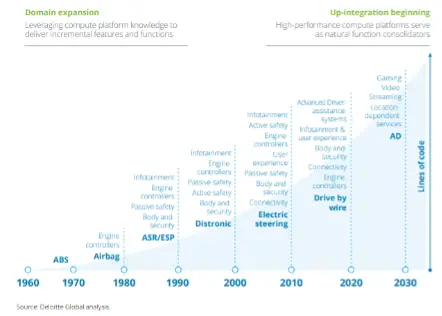
The automotive industry is transitioning to Software-Defined Vehicles (SDVs), where software drives vehicle features and functions. This shift leads to centralized electronics architectures, starting with the cockpit to simplify in-vehicle systems and meet consumer demand for advanced features.
Understanding Software-Defined Vehicles
This term was first introduced in 2018, and SDVs are projected to generate over 650 USD billion by 2030, making up 15-20% of the industry's total value. SDVs rely on software for most functionalities, enabling rapid development and integration of new features from the cloud, enhancing security, and reducing hardware dependency.

Key trends driving this transformation include autonomous, connected, electric, and shared (ACES) vehicles. These innovations shift cars from mechanical to digital platforms, where critical functions depend heavily on software. Unlike the internet industry, automotive development requires extensive embedded software, increasing the amount of in-vehicle code exponentially.
SDVs offer cost savings by simplifying mechanical systems through software control, reducing manufacturing, maintenance, and repair costs. Over-the-air (OTA) updates minimize recalls, and predictive maintenance uses sensor data to anticipate component needs, reducing breakdowns and optimizing schedules. SDVs also enhance fuel efficiency through software optimization, offering significant savings for fleet operators and high-mileage users.
The transition to SDVs requires cross-industry collaboration and innovation. The World Economic Forum’s initiative outlines four development stages:
- Connected: Initial EV adoption with basic safety features, driven by automakers with tech company support.
- Adaptive: Over-the-air updates, advanced driver-assistance systems, and digital cabin features emerge.
- Dynamic: Advanced AVs with real-time updates and customization.
- Immersive: Full self-driving capabilities, virtual reality, AI, and advanced technologies integrated into daily life.

Reframing Mobility with SDVs
SDVs offer numerous benefits:
- Cost Reduction: Simplifying systems reduces costs, with over-the-air updates minimizing recalls.
- Predictive Maintenance: Sensors and data anticipate issues, minimizing breakdowns and enhancing efficiency.
- Fuel Efficiency: Software optimization improves fuel consumption, promoting sustainability.
- Enhanced User Experience: Advanced systems and real-time updates create a personalized, safer journey.
- Innovation and Flexibility: Software-centric approach allows rapid adaptation without physical upgrades.
- Revenue Opportunities: New business models and subscription services generate revenue.
- Integration and Connectivity: Connected vehicles improve traffic management and overall road efficiency.

Cockpit Domain Controller in SDVs
E/E architecture is evolving from distributed to domain-centralized models, moving towards vehicle-centralized architecture. A High-Performance Cockpit Computer (HPCC) manages specific electronic control units (ECUs) via high-speed automotive Ethernet, optimizing features like advanced driver systems, connectivity, and over-the-air updates.
This architecture simplifies control units for OEMs. Transitioning OEMs must consider secure updates, hardware-software decoupling, silicon consolidation, and simplifying wiring harnesses. These steps enhance safety, flexibility, power efficiency, and reduce costs.
Trends in cockpit design include hyper-personalization and integrating advanced driver-assistance systems (ADAS) for safety. Connectivity serves as a hub for information, while user experience (UX) and user interface (UI) are optimized, and over-the-air updates keep technology current.
Former domain controllers are becoming powerful central computers, integrating body functions with vehicle motion and ADAS. This increases efficiency and reduces weight and complexity. Centralized computers give OEMs greater software control, enabling scalable development and hardware standardization, fostering innovation.

Automakers face challenges with advanced safety and infotainment technologies, requiring more sophisticated hardware and software, especially for autonomous driving. Higher-level autonomous vehicles will integrate streaming services, revolutionizing infotainment with personalized content. Connectivity will be crucial for delivering digital services and managing autonomous fleets. The future mix of manually and algorithmically driven vehicles will feature consolidated and personalized functions, driving the need for advanced processors and System on Chips (SoCs).
Discover how we help drive your automotive business forward here.






























